After Bach, Boccherini, Graun, and Telemann, conductor, teacher, quartet player, and viola da gambist Christophe Coin once again devotes a program to a single composer’s work that includes and/or features Coin’s chosen instrument. This time he turns his attention to the somewhat neglected though highly important Dietrich Buxtehude. While remembered primarily as J.S. Bach’s earliest mentor, Buxtehude was widely known in his day, producing a vast and diverse oeuvre throughout his relatively long life (scholars still dispute his birthplace, though the composer recognized Denmark as his native country). Coin’s focus on the gamba notwithstanding, this varied program of chamber, vocal, and solo instrumental works provides an ample introduction to Buxtehude (no similar collection of Buxtehude currently available offers this much variety) in highly spirited and engaging performances that often equal or better the competition.
Take for instance one of Buxtehude’s most famous compositions, his Sonata in B major BuxWV 255 (six recordings are currently available). This is a lovely, joyous work with a stately melodic momentum driven by imaginative violin and gamba fugues set against a harpsichord continuo. Until hearing Coin’s rendering, my reference recording of this piece was by the Boston Museum Trio on Harmonia Mundi, whose initially slow, dignified tempos eventually heighten the humor of the forthcoming fugues. Coin wastes no time here, adopting much quicker tempos right from the start. The fun begins when Coin, violinist Gilles Colliard, and additional gambist Lorenz Duftschmid fugue and counterfugue the piece into a programatic “Battalia”. This is a magnificent, virtuosic, inspired performance that all baroque chamber music fans should hear (as is another new recording of BuxWV 255 by Rare Fruits Council expatriot Manfredo Kraemer–but that’s another review).
Also included are three vocal works: two cantatas and an elegy, Muss der Tod denn auch entbinden, was kein Fall entbinden Kann? (Must death then separate what nothing else can separate?) devoted to Buxtehude’s then recently-deceased father. While the first two cantatas are certainly expertly composed and beautifully performed, the elegy is absolutely sublime. Soprano Bénédicte Tauran shines here, delivering a subtler, darker, more fitting rendering compared to Emma Kirkby on Dacapo.
It’s widely acknowledged that Buxtehude’s organ works greatly influenced the young J.S. Bach, and fittingly, Coin programs three excellent examples here. Included are the chorales Fried und Freudenreiche Hinfahrt des alten grossglaubingen Simeons, Mit Fried und Freud ich fahr dahin, and a closing Toccata in D minor that remarkably sounds as if it were a preliminary study or a basis for Johann Sebastian’s celebrated Toccata and Fugue in D minor BWV 565. Organist Jan Willem Jansen’s performances are generally fine, though I miss the imagination Michel Chapuis on Valois brings to the chorales and the authority Harald Vogel on MDG instills in his rendering of the Toccata. Naïve’s sound is sumptuous, richly detailed, and plainly beautiful. Gilles Cantagrel and Charles Johnston’s notes are informative and entertaining. In all, this is an extraordinarily intelligent, thoughtful musical program.
































